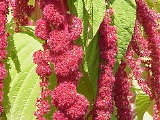
Amaranthus caudatus
Encyclopedia
Amaranthus caudatus is a species of annual flowering plant
. It goes by common name
s such as love-lies-bleeding, love-lies-a'bleeding, pendant amaranth, tassel flower, velvet flower, foxtail amaranth, and quelite
. Many parts of the plants, including the leaves and seeds, are edible, and are frequently used as a source of food in India
and South America
— where it is the most important Andean
species of Amaranthus, known as Kiwicha (see also Andean ancient plants). This species, as with many other of the amaranths, are originally from the American tropics. The exact origin is unknown, as A. caudatus is believed to be a wild Amaranthus hybridus
aggregate.
The red color of the inflorescences is due to a high content of betacyanins
, like in the related species known as "Hopi red dye" amaranth. Ornamental garden varieties sold under the latter name are either Amaranthus cruentus
or a hybrid between A. cruentus and Amaranthus powelli. In indigenous agriculture, Amaranthus cruentus is the Central American counterpart to South American Amaranthus caudatus.
Amaranth is used in Thai cuisine where it is known as Pak Khom (ผักขม)
In most of its range it is planted as a summer annual. In temperate regions plants can be started indoors in early spring and transplanted outdoors after the last frost.
Flowering plant
The flowering plants , also known as Angiospermae or Magnoliophyta, are the most diverse group of land plants. Angiosperms are seed-producing plants like the gymnosperms and can be distinguished from the gymnosperms by a series of synapomorphies...
. It goes by common name
Common name
A common name of a taxon or organism is a name in general use within a community; it is often contrasted with the scientific name for the same organism...
s such as love-lies-bleeding, love-lies-a'bleeding, pendant amaranth, tassel flower, velvet flower, foxtail amaranth, and quelite
Quelite
Quelite can mean any of a number of different plants eaten in Mexico for their leaves, as leaf vegetables or herbs, including but not limited to:* Amaranthus species* Chenopodium species* Coriandrum speciesSee also:...
. Many parts of the plants, including the leaves and seeds, are edible, and are frequently used as a source of food in India
India
India , officially the Republic of India , is a country in South Asia. It is the seventh-largest country by geographical area, the second-most populous country with over 1.2 billion people, and the most populous democracy in the world...
and South America
South America
South America is a continent situated in the Western Hemisphere, mostly in the Southern Hemisphere, with a relatively small portion in the Northern Hemisphere. The continent is also considered a subcontinent of the Americas. It is bordered on the west by the Pacific Ocean and on the north and east...
— where it is the most important Andean
Inca Empire
The Inca Empire, or Inka Empire , was the largest empire in pre-Columbian America. The administrative, political and military center of the empire was located in Cusco in modern-day Peru. The Inca civilization arose from the highlands of Peru sometime in the early 13th century...
species of Amaranthus, known as Kiwicha (see also Andean ancient plants). This species, as with many other of the amaranths, are originally from the American tropics. The exact origin is unknown, as A. caudatus is believed to be a wild Amaranthus hybridus
Amaranthus hybridus
Amaranthus hybridus, commonly called Smooth Amaranth, Smooth Pigweed, Red Amaranth, or Slim Amaranth, is a species of annual flowering plant. It is a weedy species found now over much of North America and introduced into Europe and Eurasia.-Description:A. hybridus grows from a short taproot and can...
aggregate.
The red color of the inflorescences is due to a high content of betacyanins
Betalain
Betalains are a class of red and yellow indole-derived pigments found in plants of the Caryophyllales, where they replace anthocyanin pigments. Betalains also occur in some higher order fungi. They are most often noticeable in the petals of flowers, but may color the fruits, leaves, stems, and...
, like in the related species known as "Hopi red dye" amaranth. Ornamental garden varieties sold under the latter name are either Amaranthus cruentus
Amaranthus cruentus
Amaranthus cruentus is a common flowering plant species that yields the nutritious staple amaranth grain. It is one of three Amaranthus species cultivated as a grain source, the other two being Amaranthus hypochondriacus and Amaranthus caudatus...
or a hybrid between A. cruentus and Amaranthus powelli. In indigenous agriculture, Amaranthus cruentus is the Central American counterpart to South American Amaranthus caudatus.
Amaranth is used in Thai cuisine where it is known as Pak Khom (ผักขม)
Cultivation
A. caudatus can grow anywhere from 3 to 8 feet in height, and grows best in full sun. It can handle a variety of conditions, both humid and arid. It is easily grown from seed.In most of its range it is planted as a summer annual. In temperate regions plants can be started indoors in early spring and transplanted outdoors after the last frost.
External links
- Jepson Manual Treatment
- USDA Plants Profile
- Ecoport token for Amaranthus caudatus L.
- "Wild Food Plants Attracting Additional Consumer Categories": Amaranthus caudatus (Famine Food Guide website)
- Photo gallery

